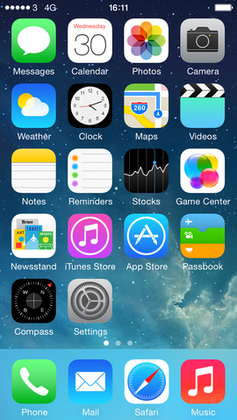| Version of the iOS operating system | |
 | |
 iOS 7.1 home screen, showing the redesigned user interface | |
| Developer | Apple Inc. |
|---|---|
| Source model | Closed, with open source components |
| Initial release | September 18, 2013 |
| Latest release | 7.1.2 (11D257) / June 30, 2014 |
| Update method | Software Update |
| Package manager | App Store |
| Platforms | |
| Kernel type | Hybrid (XNU) |
| License | Proprietary EULA, except for open-source components |
| Preceded by | iOS 6 |
| Succeeded by | iOS 8 |
| Official website | Apple - iOS 7 at the Wayback Machine (archived September 8, 2014) |
| Tagline | The mobile OS from a whole new perspective. |
| Support status | |
| Obsolete, unsupported. Drops support for the iPhone 3GS and iPod Touch (4th generation). | |
iOS 7 is the seventh major release of the iOS mobile operating system developed by Apple Inc., being the successor to iOS 6. It was announced at the company's Worldwide Developers Conference on June 10, 2013, and was released on September 18 of that year. It was succeeded by iOS 8 on September 17, 2014.[2]
iOS 7 introduced a completely redesigned user interface, a design credited to a team led by Apple's former senior vice president of design, Jony Ive. The new look, featuring flatter icons, a new slide-to-unlock function, and new animations, was described by Ive as "profound and enduring beauty in simplicity." The new design was implemented throughout the operating system, including the Notification Center, which was updated with three tabs offering different views of information, notifications visible on the lock screen; a redesigned Siri voice assistant offering visual indicators, and a Control Center offering easy access to the most commonly used features. iOS 7 also introduced AirDrop, a wireless sharing technology, CarPlay, phone and car integration; and automatic app updates in the App Store. iOS 7 was the first version of iOS to support 64-bit apps and processors.[3]
Reception of iOS 7 was mixed. The new design language was criticized, with critics noting the implementation of design changes rather than actual productivity improvements, and citing examples such as animations delaying access, lack of icon consistency, and buttons being hidden as negative aspects of the user experience. The addition of the Control Center was praised, as were updates to Siri and multitasking. Shortly after release, there were reports of the new design causing sickness, a trend explained as being caused by animations with similar effects as car sickness.
User adoption of iOS 7 was fast. Its iOS market share was reported to be as high as 35% after one day, and installed on 200 million devices within 5 days, which Apple stated was "the fastest software update in history."
iOS 7 is the last version of iOS that supports the iPhone 4.
- ^ "iOS 7 on iPod Touch 4g". GitHub.
- ^ Hall, Zac (September 9, 2014). "Apple releases iOS 8 GM ahead of Sep. 17 public release". 9to5Mac. Archived from the original on May 13, 2019. Retrieved December 30, 2016.
- ^ Wollman, Dana (September 10, 2013). "iOS 7 will be 64-bit, just like the iPhone 5s' new A7 chip". engadget. Archived from the original on December 20, 2020. Retrieved January 3, 2023.